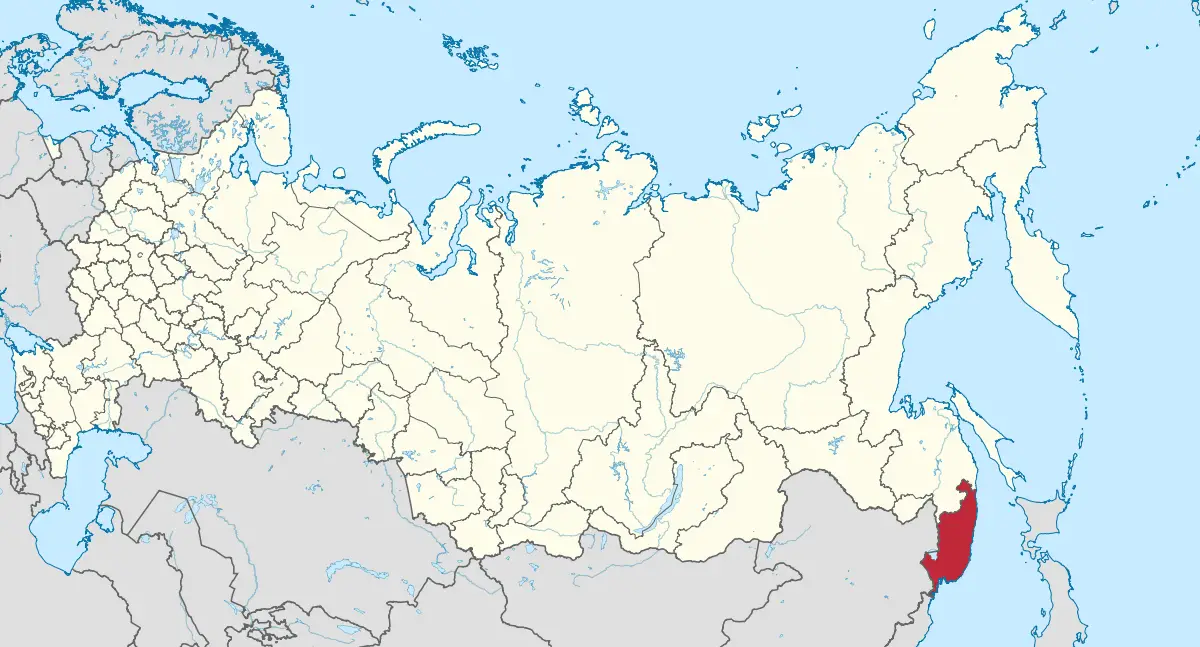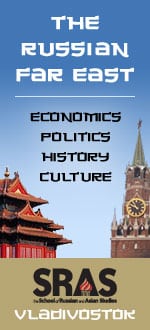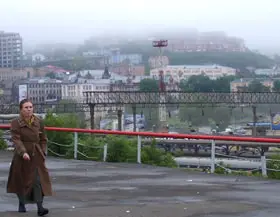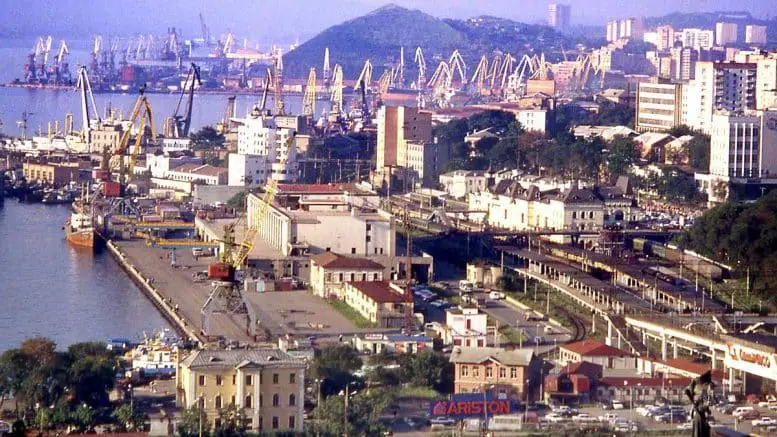
Primorsky Krai, where Vladivostok is located (near the southern tip).
The construction of Vladivostok was the culmination of Russia’s long drive to establish a major naval presence in the Pacific Ocean and help solidify its hold on the eastern portion of its empire. The land it the city is built on was previously claimed (but, many say, never effectively ruled) by China. It was sparsely populated by Chinese and indigenous peoples when the region was transferred to Russia via the Treaty of Aigun from the Chinese Qing Empire in 1858 at Russia’s request. Russia had already moved troops and settlers into the region and the Qing Empire, then relatively weak, felt it had little choice in ceding the territory

The area also had obvious value as a diplomatic and economic outpost – lying just a short boat ride from Japan, China, and the Korean peninsula.
In 1871, Russia’s Pacific Fleet (then known as the Siberian Military Flotilla) was moved to Vladivostok from Nikolayevsk-on-Amur and bolstered with several ships sent from the Baltic Fleet (based in St. Petersburg). At the same time, the commercial port was also moved from Nikolayevsk-on-Amur, giving a boost to the economy. In 1903, the Trans-Siberian Railway connected to the city, opening it to the valuable markets located in the west.

A woman strolls the hilly streets of Vladivostok. Photo by former SRAS student Joshua Blackwelder.
By the time the Russo-Japanese War started in 1904, the city was a major part of the Russian empire. Several theatres had been opened, newspapers were being published, and an institution of higher education, the Oriental Institute, had been founded. There were hundreds of buildings lining lighted streets, interspersed with parks and trees.
Vladivostok suffered heavy losses in that war, but recovered relatively quickly. Afterwards, despite revolts by local sailors in 1906, it would continue to grow until the Revolution began in 1917. As WWI was still raging, American, British, and Japanese forces occupied the city together with White Army troops in order to protect supplies, supply lines, and the British and Japanese citizens still resident in the city. The armies collectively resisted the Red Army during the Russian Civil War. The fall of Vladivostok in 1922, after the end of WWI and the departure of the foreign troops, is often cited as one of the final events of the Civil War, sealing the Bolshevik victory.
Under the Soviets, growth and development continued with industrial, military, communication, and transportation infrastructure all being built. The region around the city would also be home to several gulags to house political prisoners and POWs in WWII and the Korean War (including several American and Chinese pilots who served in the later). Vladivostok was declared a “closed” city in 1958 – meaning that those visiting the city (even Soviet citizens) had to obtain special permission to enter. Vladivostok “reopened” in 1991.
Today, the city of Vladivostok has an official population of about 600,000, consisting mostly of ethnic Russians, with small minorities of Chinese, Koreans, Japanese, and indigenous peoples. However, there are a great number of illegal Chinese immigrants in the city, which staff the city’s most popular markets and restaurants. While the total number of Chinese there is not exactly known, many estimates put the number at around 10,000 and the influences of Chinese culture in the city’s daily life can be easily felt.
One of only four major seaports serving a gigantic country, Vladivostok has become a major commercial hub – mainly for goods brought from China, Japan, and Korea, and through both legal and illegal means.
Take one of the city’s best known industries: the importation of automobiles. Many of Vladivostok’s early car importers got their starts by essentially pirating ships loaded with Japanese cars that arrived to the then relatively ill-guarded and corrupt port. In a National Geographic article published this July entitled “Road Tripping the Trans-Siberian,” two reporters tell of meeting such men. According to their stories, the process was simple: hold up a boat with some guns and some friends, steal one of the cars, sell it, and use the proceeds to continue to buy and sell cars.
Car importing remains a big business (and is now much better regulated, although the city retains a reputation for corruption). In parking lots around the port, one can always find “peregonshikii.” This is the Russian term for those who work driving cars over the still largely unpaved and ill-kept highway that links Vladivostok to the booming car markets in western Russia. The cars are driven individually rather than in larger transport trucks.
Auto importation is, of course, not the city’s only industry. Other major industries center largely on the port: fishing, shipping, and ship building and repair – including maintenance of the naval fleet which is still based there.
Over the last few years, the city’s troubled mayoral office has been the source of unpleasant headlines. In 2004, shortly after losing his reelection bid, former mayor Yuri Kopylov was arraigned on charges of “abuse of office” for handing a construction contract to a company without accepting other tenders. He was given a four-year suspended sentence. His successor, Vladimir Nikolaev, was also put on trial in 2007 and removed from office on charges that he had illegally paid for security services with municipal funds. Seeing two mayors on trial in just a few years, voter participation in mayoral campaigns has sunk by 50% since the start of the decade.
Environmental issues are also a concern for the city. While the city proper is slightly better off, two-thirds of Vladivostok’s suburbs are categorized as too polluted to be lived in. Local geographic conditions compound the problem, with high hills preventing winds from sweeping out the air pollution. According to investigative reporting from the International Herald Tribune, funds intended to address the environmental issues get siphoned off, and only 1% funds that come from fines on polluters are used for their intended purpose: fighting pollution.
The city has also recently been the focus of investment, including new construction and renovations. It has made itself more hospitable to business people and tourists – and several English-speaking, luxury hotels have sprung up. The local train station and the airport have both been refurbished. Several foreign companies now have a presence there. However, nearly all complain that heavy bureaucracy and crumbling infrastructure (in everything from transport to logistics to communications) are holding back Vladivostok from its full potential as an economic hub. Also, according to government estimates, (in perhaps what should be seen as a conservative estimate), 25% of the population lives below the poverty line. With that statistic, retail and service sectors are also obviously held back.

A US naval ship and sailors in Vladivostok.
Despite its problems, Vladivostok’s residents are often proud to be part of the “Eastern Ruler” of Russia. With its steep hills looking down on ships and ports, and streets dotted with Chinese and Korean shops and restaurants, the city is often compared to San Francisco in its look and feel.
The city also hosts nine universities. Far Eastern National University (FENU), based in Vladivostok, is one of Russia’s five largest institutions with 40,000 plus students. It was also ranked thirteenth in the last ranking of top universities in Russia by Russia’s Ministry of Education. FENU will soon become the basis of a new “Far Eastern Federal University,” meaning more federal funds, the construction of new facilities (particularly for the sciences), and the ability to absorb other universities (such as Khabarovsk State, which has already become the Far Eastern National University for the Humanities).
Adding to the city’s eclectic culture, the United States Navy also holds a regular presence there and regularly provides sailors with shore-time there. The Navy also often hosts goodwill events in Vladivostok – everything from Fourth of July celebrations to sandwich-making competitions (as was held in early 2008).
Students have mentioned that other points of interest include exploring the port’s submarine museums, visiting the historic train station, trying the excellent local Chinese food and just strolling the hilly city streets. Visiting the taiga that lies just above the city is also popular for tourists, as the forest is home to tigers and other exotic and endangered species.
Like many cities today, Vladivostok battles pollution, depleting resources, corruption, and poverty. But its strategic location and its proximity to East Asian countries makes it a vital outpost for Russia and an extremely interesting experience for students and tourists.
Learn More about Programs in Vladivostok!


